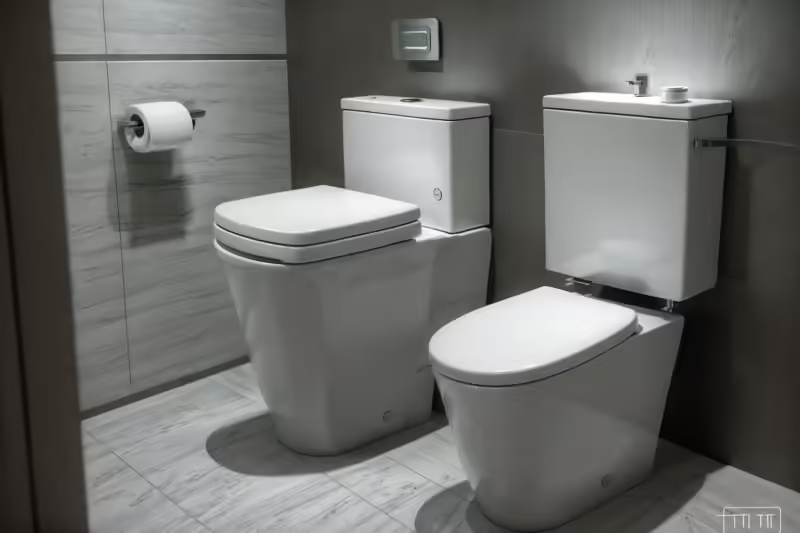
The modern toilet bowl, an essential household item, has evolved in design and function to suit contemporary lifestyles. From sleek, minimalist ceramic pieces to multifunctional designs incorporating innovative materials like silicone, modern bowls cater to a variety of uses, from dining to decor. Image source: Interior AI
Read these first:
- Environment 101: Toilets -When Some Malaysians Unfairly Laugh At India
- Prepping 101: Doomsday Bunker – Part 4: Waste Management And Disposal & Clean Fresh Air Supply
- Overseas Assignment 2012: Myanmar Adventure Part 3 – Terrible Food Poisoning
- Mandatory Quarantine 2020: Part 3 – Arriving At Home Away From Home
- Environment 101: Understanding Malaysia’s 2016 Positive Greenhouse Gas Emission Edge
Introduction
Modern toilets, an essential yet often overlooked part of our daily lives, have a history that stretches back thousands of years. The evolution of sanitation systems reflects the advancements in human civilization and our ongoing pursuit of health and hygiene. From rudimentary holes in the ground to sophisticated modern plumbing, the journey of toilets is a testament to human ingenuity and adaptability.
Throughout history, the development of toilets has paralleled societal growth and technological progress. Early sanitation systems, such as the ancient Roman public latrines, showcased the importance of communal health and cleanliness. As societies advanced, so did their waste management solutions, leading to the creation of flush toilets and modern sewage systems that we often take for granted today.

In ancient Rome, sanitation was a public affair. Romans used communal latrines, which were essentially long stone benches with holes, placed over a flowing water system that carried waste away. These facilities were not only a place for relieving oneself but also served as social hubs where Romans would chat and catch up with news. The most famous of these ancient sewers is the Cloaca Maxima, which is still visible in Rome today. Interestingly, instead of toilet paper, Romans used a sponge on a stick, which was rinsed in water between uses. Image source: Flickr
Ancient Sanitation Systems
The history of sanitation systems dates back to the dawn of civilization, with some of the earliest known practices emerging in Mesopotamia, Egypt, and Rome. These ancient societies were pioneers in plumbing and public health, laying the groundwork for the advanced toilet technology we benefit from today.
In Mesopotamia, around 4000 BCE, rudimentary sanitation systems began to take shape. The Mesopotamians developed clay pipes to facilitate the drainage of waste water, a significant innovation for its time. These early systems were primarily focused on protecting public health by removing waste from living areas, thus preventing the spread of diseases.
Similarly, ancient Egypt made notable contributions to the evolution of sanitation. The Egyptians constructed sophisticated drainage systems and toilets in their homes, typically consisting of a wooden seat over a container filled with sand. Public baths were also a common fixture in Egyptian society, underscoring the importance of cleanliness and hygiene.
The Romans, however, were perhaps the most advanced of these early civilizations in terms of sanitation. By around 500 BCE, Rome had developed an extensive network of aqueducts and sewers, including the famous Cloaca Maxima, one of the world’s earliest sewage systems. Roman public baths, or thermae, were not only centers of social activity but also crucial for public health. Communal toilets, known as latrines, were a standard feature in Roman cities, showcasing an advanced understanding of urban planning and sanitation.
These ancient sanitation systems were pivotal in shaping the development of modern toilet technology. They highlighted the critical role of sanitation in public health and laid the foundation for future innovations. The principles established by Mesopotamian, Egyptian, and Roman engineers continue to influence our approach to plumbing and waste management today, ensuring that the progress made thousands of years ago still benefits us in the present.
Please accept YouTube cookies to play this video. By accepting you will be accessing content from YouTube, a service provided by an external third party.
If you accept this notice, your choice will be saved and the page will refresh.
.
In Malaysia, the practice of using buckets to collect night soil persisted well into the early 1980s. I remember that in some pre-war housing areas near my grandmother’s house, night soil collectors would come late at night to gather human waste, which was likely used as fertilizer in the vegetable gardens on the village outskirts. Thankfully, my grandmother’s house was equipped with modern plumbing, featuring a contemporary, albeit squat-style, toilet.
Dark Ages of Sanitation
The transition from the sophisticated sanitation systems of ancient civilizations to the medieval period marked a significant decline in public health and hygiene. During this era, the use of chamber pots became prevalent across Europe. These rudimentary devices were essentially small, portable containers used for human waste, which were often emptied into the streets or nearby water sources. This practice led to severe sanitation issues, contributing to the spread of diseases and poor public health conditions.
The lack of proper sewage systems during the medieval period exacerbated these health problems. Unlike the Roman aqueducts and sewer systems that had once efficiently managed waste, medieval towns and cities lacked any structured means of dealing with human excrement. Waste would accumulate in the streets, contaminating water supplies and creating a breeding ground for pathogens. This unsanitary environment significantly impacted urban populations, leading to frequent outbreaks of diseases such as cholera and dysentery.
However, the Renaissance period sparked a gradual resurgence in sanitation practices. Intellectual and technological advancements began to pave the way for improved hygiene. One notable figure in this era was Sir John Harington, who invented the flush toilet in the late 16th century. Harington’s invention, though initially met with skepticism, was a significant milestone in the history of sanitation. His design featured a valve that released water from a cistern to flush away waste, laying the groundwork for modern plumbing systems.
This period also saw the beginning of more organized approaches to waste management. Cities started to implement rudimentary sewer systems and public health measures aimed at controlling the spread of disease. These efforts marked the end of the medieval sanitation dark ages and set the stage for the more sophisticated systems that would develop in the ensuing centuries.

Thomas Crapper, baptized on September 28, 1836, was an influential English plumber and businessman who founded Thomas Crapper & Co in London. Contrary to popular belief, he did not invent the flush toilet but made significant contributions to its development, such as improving the S-bend plumbing trap with his invention of the U-bend. His company gained notoriety for quality products and received royal warrants, with Crapper’s name becoming synonymous with toilets due to the widespread use of his products and a touch of historical humor. Image source: Wikipedia
Industrial Revolution and Modern Plumbing
The 19th century marked a pivotal era in the evolution of toilets, primarily driven by the Industrial Revolution. This period witnessed groundbreaking advancements in both toilet technology and sanitation, significantly improving urban living conditions.
One of the most notable developments was the advent of modern indoor plumbing. Prior to this, most people relied on outdoor privies or chamber pots, which were emptied manually. The introduction of indoor plumbing transformed these rudimentary systems, making sanitation more accessible and efficient.
The flush toilet, a revolutionary invention, began to gain widespread adoption during this time. Although the concept of a flushing mechanism existed earlier, it was in the 19th century that it became more refined and practical for everyday use. Thomas Crapper, a prominent figure in the plumbing industry, played a crucial role in popularizing the flush toilet. Contrary to popular belief, Crapper did not invent the flush toilet, but he did contribute significantly to its development and commercialization. His improvements in the design, coupled with effective marketing strategies, made the flush toilet a household staple.
These advancements had a profound impact on public health and urban living conditions. The implementation of modern plumbing systems and the widespread adoption of flush toilets helped to reduce the prevalence of waterborne diseases, which were rampant in densely populated cities. The improved sanitation infrastructure facilitated better waste management, reducing the contamination of drinking water sources and leading to a healthier urban populace.
The 19th century’s innovations in toilet technology were more than just technical achievements; they were instrumental in shaping modern urban life. The integration of efficient plumbing systems and the acceptance of the flush toilet as a standard household fixture marked a significant leap forward in public health and hygiene. This era laid the groundwork for the sophisticated sanitation systems we benefit from today, underscoring the importance of continuous innovation in improving living standards.
Please accept YouTube cookies to play this video. By accepting you will be accessing content from YouTube, a service provided by an external third party.
If you accept this notice, your choice will be saved and the page will refresh.
.
Japan has been at the forefront of modern toilet technology for decades, pioneering the development and use of advanced toilets that offer a range of smart features. These innovative fixtures, which include bidet functions, seat warming, and even music, were widely adopted in Japan well before they gained popularity globally. As the rest of the world begins to embrace the comfort and convenience of smart toilets, it’s clear that Japan’s early adoption and continuous innovation have set a high standard in bathroom technology.
Modern Toilets
The evolution of toilet technology over the past several decades has been nothing short of remarkable. Reflecting on the simpler, less sophisticated toilets of my childhood, it is evident how far we have come in terms of design, functionality, and overall user experience. Back then, toilets were basic, utilitarian fixtures primarily focused on fulfilling a single purpose. They lacked the intricate engineering and technological enhancements that characterize today’s models.
Modern toilets have transcended their traditional role as mere functional necessities. Contemporary designs incorporate a plethora of advanced features that enhance comfort, hygiene, and convenience. Heated seats, for instance, are now common in many high-end models, providing a warm and comfortable seating experience, especially during colder months. Bidets, once considered a luxury, have become more accessible, offering improved cleanliness and comfort. These enhancements reflect a significant shift in how we perceive and utilize bathroom fixtures.
Furthermore, the integration of smart technology has revolutionized the way we interact with toilets. Smart toilets can now be controlled via remote or smartphone apps, allowing users to customize settings such as water temperature, pressure, and even ambient lighting. Some models are equipped with self-cleaning functions, automatic lid openers, and deodorizers, ensuring a more hygienic and pleasant user experience. These technological advancements not only elevate the functionality of toilets but also contribute to a more sustainable and efficient use of resources.
In addition to functionality, modern toilet designs prioritize aesthetics and space efficiency. Sleeker lines, compact forms, and environmentally friendly materials have become standard in contemporary bathroom design. These improvements highlight the ongoing innovation in the field, aimed at creating toilets that are not only practical but also visually appealing and environmentally conscious.
Final Say
The journey of toilet evolution, from rudimentary ancient systems to modern-day sophisticated sanitation solutions, underscores the significant strides humanity has made in enhancing public health and hygiene. This progression is a testament to human ingenuity and the relentless pursuit of better living conditions. As I reflect on my personal experiences as a small boy, I am reminded of the transformative power of these advancements. The transition from basic facilities to modern toilets mirrors my own journey of growth and understanding.
The importance of sanitation in human development cannot be overstated. Improved toilet technologies have not only reduced the prevalence of disease but have also contributed to the overall quality of life. These advancements have facilitated cleaner environments, safeguarded water sources, and promoted healthier communities. On a personal level, the evolution of toilets has provided me with a deeper appreciation of the importance of hygiene and its impact on our daily lives.
Looking ahead, the future of toilet technology holds promising possibilities. Innovations such as water-saving mechanisms, eco-friendly materials, and smart toilets equipped with health monitoring features are set to revolutionize our approach to sanitation. These advancements have the potential to address current challenges, such as water scarcity and environmental sustainability while continuing to improve public health standards.
In conclusion, the evolution of toilets is a narrative of progress and perseverance. It reflects our collective commitment to creating a better, healthier world. My personal experiences serve as a microcosm of this larger journey, highlighting the profound impact that improved sanitation can have on individual lives and society as a whole.
As we stand on the brink of future innovations, it is imperative to continue prioritizing advancements in toilet technology, ensuring that the benefits of modern sanitation are accessible to all. This forward-looking perspective inspires optimism and a renewed dedication to fostering a cleaner, healthier future for generations to come.